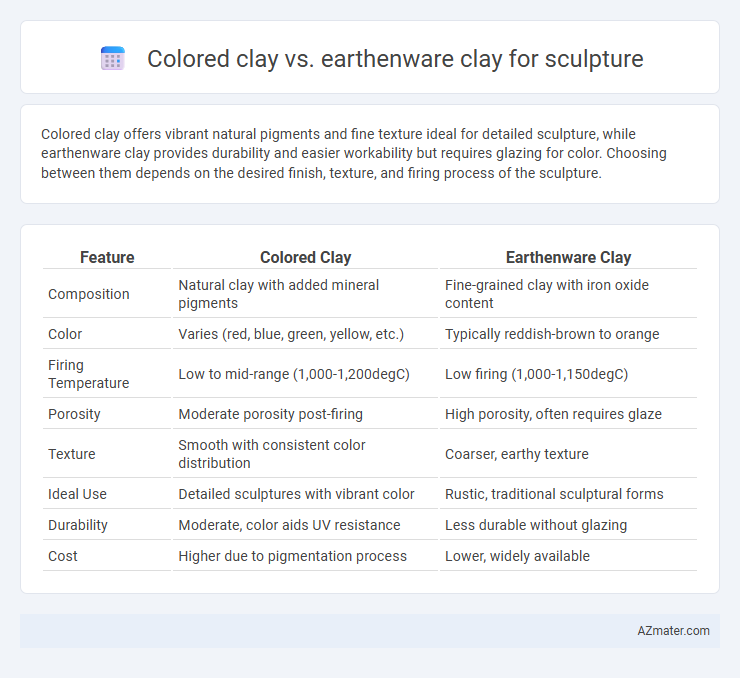Colored clay offers vibrant natural pigments and fine texture ideal for detailed sculpture, while earthenware clay provides durability and easier workability but requires glazing for color. Choosing between them depends on the desired finish, texture, and firing process of the sculpture.
Table of Comparison
| Feature | Colored Clay | Earthenware Clay |
|---|---|---|
| Composition | Natural clay with added mineral pigments | Fine-grained clay with iron oxide content |
| Color | Varies (red, blue, green, yellow, etc.) | Typically reddish-brown to orange |
| Firing Temperature | Low to mid-range (1,000-1,200degC) | Low firing (1,000-1,150degC) |
| Porosity | Moderate porosity post-firing | High porosity, often requires glaze |
| Texture | Smooth with consistent color distribution | Coarser, earthy texture |
| Ideal Use | Detailed sculptures with vibrant color | Rustic, traditional sculptural forms |
| Durability | Moderate, color aids UV resistance | Less durable without glazing |
| Cost | Higher due to pigmentation process | Lower, widely available |
Introduction to Colored Clay and Earthenware Clay
Colored clay offers vibrant hues naturally embedded within the clay matrix, eliminating the need for surface painting and allowing for detailed, textured sculptures with inherent color depth. Earthenware clay, characterized by its porous structure and low firing temperature (typically between 1,000 and 1,150degC), provides excellent workability and is widely favored for traditional sculpting techniques and post-firing glazing. Both clays deliver unique aesthetic and functional qualities, with colored clay emphasizing chromatic expression and earthenware prioritizing versatility and structural integrity.
Key Characteristics of Colored Clay
Colored clay features natural or added pigments that provide vibrant hues without the need for surface glazing, enhancing the visual depth of sculptures. It typically exhibits a fine texture and consistent plasticity, which allows for precise detailing and smooth finishes in sculptural work. Compared to earthenware clay, colored clay often has a more controlled shrinkage rate and firing temperature, contributing to the durability and stability of the finished piece.
Key Characteristics of Earthenware Clay
Earthenware clay is characterized by its porous nature and low firing temperature, typically between 1,000degC and 1,150degC, which makes it softer and more absorbent compared to colored clay. It exhibits a rich, natural reddish-brown or buff hue due to high iron content, providing a warm aesthetic that is ideal for rustic or traditional sculptures. This clay's plasticity allows for easy shaping and fine detailing, but it requires sealing or glazing to prevent moisture absorption and enhance durability in finished pieces.
Differences in Composition and Texture
Colored clay contains natural or synthetic pigments mixed into the base clay, providing a variety of vibrant hues without requiring surface painting, while earthenware clay typically remains in its natural reddish-brown or buff tone. The composition of colored clay often includes added mineral oxides for pigmentation, which can slightly alter plasticity and firing temperature compared to traditional earthenware. In texture, earthenware clay is generally coarse and porous, ideal for rustic sculptures, whereas colored clay tends to have a smoother consistency suited for fine detailing in artistic works.
Workability for Sculptors
Colored clay often contains additional pigments and minerals that can affect its texture and plasticity, making it slightly less pliable than traditional earthenware clay. Earthenware clay typically offers superior workability for sculptors due to its smooth consistency and responsiveness to hand-building techniques. Sculptors seeking maximum flexibility and ease of shaping usually prefer earthenware clay, especially for detailed or intricate designs.
Color Potential and Pigmentation
Colored clay offers inherent pigmentation that eliminates the need for external colorants, maintaining color consistency throughout the sculpture even after firing. Earthenware clay, typically a natural reddish-brown or buff color, provides a neutral base that can be enhanced with glazes or stains, allowing for more surface-level customization but risking uneven color absorption. The choice between colored clay and earthenware depends on whether intrinsic color permanence or versatile surface pigmentation is prioritized in the sculptural work.
Firing Temperatures and Durability
Colored clay typically fires at lower temperatures, around 1,800degF to 2,100degF (980degC to 1,150degC), which preserves its natural pigmentation but may result in less durability compared to earthenware clay. Earthenware clay generally fires between 1,830degF and 2,100degF (1,000degC to 1,150degC), offering a balance between plasticity and strength, though it remains more porous and less durable than stoneware or porcelain. Both clays require careful firing control to optimize structural integrity, with earthenware being more prone to chipping and colored clay potentially losing vividness if overfired.
Artistic Effects and Finishing Options
Colored clay offers vibrant natural hues directly in the material, reducing the need for surface painting and allowing artists to achieve consistent, rich color throughout their sculptures. Earthenware clay provides a warm, porous base with a wide range of glaze options that produce varied textures, finishes, and color effects after firing, enhancing artistic expression through surface treatments. The choice between colored clay and earthenware clay influences the final aesthetic significantly, as colored clay emphasizes intrinsic color permanence while earthenware allows for dynamic glazing and finishing experimentation.
Cost and Accessibility Comparison
Colored clay often comes pre-mixed with pigments, making it more expensive and less versatile than earthenware clay, which is widely available and budget-friendly for sculptors. Earthenware clay offers easy access through most art supply stores and allows artists to paint or glaze their sculptures after firing, providing more flexibility at a lower cost. For beginners or those working on large projects, earthenware clay is typically the preferred choice due to its affordability and accessibility.
Choosing the Right Clay for Sculpture
Choosing between colored clay and earthenware clay for sculpture depends on the desired aesthetic and firing requirements. Colored clay offers vibrant natural hues that eliminate the need for surface painting, while earthenware clay provides a versatile, traditional medium that can be glazed for varied finishes. Both clays have different firing temperatures--colored clay typically fires at mid-range temperatures, whereas earthenware clays mature at lower temperatures--impacting durability and final color outcome in sculptures.

Infographic: Colored clay vs Earthenware clay for Sculpture
 azmater.com
azmater.com